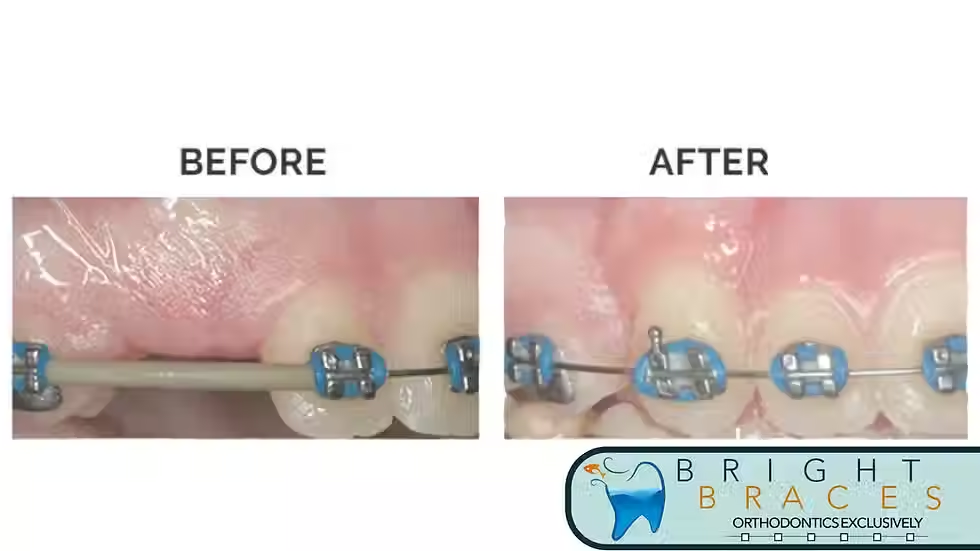Braces for Impacted Canines: What to Expect from Treatment
- Bright Braces

- Feb 26
- 3 min read
Updated: Oct 30

Canine teeth, also called cuspids or eye teeth, are important for a balanced bite and proper dental alignment. However, sometimes these teeth fail to erupt properly, getting trapped beneath the gums. This is known as an impacted canine.
Impacted canines are a common orthodontic concern, especially in the upper jaw. If left untreated, they can cause misalignment, pain, and even damage to nearby teeth. Fortunately, braces combined with specialized orthodontic techniques can guide the impacted tooth into place and restore a healthy, symmetrical smile.
If you or your child has an impacted canine, here’s what to expect from the treatment process.
How Braces Help Fix an Impacted Canine
Braces are one of the most effective ways to treat an impacted canine without extraction. The process involves:
Creating space for the canine to erupt naturally
Surgically exposing the impacted tooth if necessary
Gently guiding the tooth into alignment using orthodontic traction
Since impacted canines vary in severity, treatment may take anywhere from several months to two years, depending on how deep the tooth is positioned.
Step-by-Step Treatment Process
Orthodontic Evaluation and X-Rays
The first step in treating an impacted canine is a comprehensive orthodontic evaluation. Your orthodontist will:
Perform a clinical examination to check for signs of impaction
Take X-rays or 3D scans to determine the exact position of the impacted tooth
Discuss the best treatment approach, which may include braces, space maintainers, or oral surgery
The ideal age for early intervention is between 11 and 14 years old, but adults can still benefit from treatment.
Creating Space with Braces
Before moving the impacted tooth, your orthodontist will use braces or an orthodontic expander to create enough space in your dental arch. This step ensures there is room for the canine to move into its proper position.
Braces apply gentle pressure to shift surrounding teeth, preventing crowding and allowing the impacted canine to emerge correctly. This stage may take a few months, depending on how much space is needed.
Surgical Exposure of the Impacted Canine
If the canine tooth does not erupt on its own, a minor surgical procedure may be necessary. This is done by an oral surgeon or periodontist and involves:
Making a small incision in the gums to expose the impacted tooth
Attaching a small bracket or gold chain to the tooth
Connecting the chain to the braces so the tooth can be gently pulled into position
The procedure is usually performed under local anesthesia and has a short recovery time.
Guided Eruption with Braces
Once the impacted canine is exposed and connected to the braces, the orthodontist will begin gradually pulling it into the correct position. This process can take several months, as slow movement ensures the tooth stays healthy and does not damage surrounding teeth.
Final Alignment and Bite Correction
Once the canine is properly positioned, the orthodontist will continue refining the alignment of all the teeth. Rubber bands or other orthodontic techniques may be used to ensure a balanced bite.
When the treatment is complete, the braces will be removed, and a retainer will be provided to maintain the new alignment.
How Long Does Treatment Take?
The total time for braces and impacted canine correction varies based on the severity of the impaction. On average:
Minor cases can take six to 12 months
Moderate cases may take 12 to 24 months
Severe cases requiring extensive movement can take up to two years
Every patient is different, and the orthodontist will provide a more specific timeline after an evaluation.
What to Expect During Recovery and Treatment
Patients may experience mild discomfort, especially after adjustments or surgery. Pain can be managed with over-the-counter pain relievers and soft foods. Good oral hygiene is essential to prevent infection and ensure the best results.

Schedule a Consultation for Impacted Canine Treatment
If you or your child has an impacted canine, early treatment can make a big difference. Schedule a consultation with Bright Braces to learn more about how braces can help guide the tooth into place and create a healthy, beautiful smile.




Comments